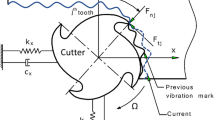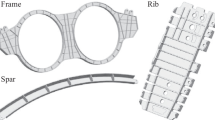Abstract
This paper presents an analytical model for identifying process damping caused by interference between tool and workpiece during the cutting process. In contrast to the traditional discrete method, the model identifies the interference area between tool and workpiece using a complete analytical method. The obtained interference area can achieve the accuracy of the result obtained by using a shorter discrete step, but the time required for the model is shorter than that of the discrete method and is unaffected by the discrete step. The influence of tool wear band on the process damping coefficient is also considered. The process damping coefficient is identified based on the interference area obtained by the complete analytical model, and the damping coefficient of the non-linear process is linearized by the energy method. Finally, the cutting stability lobe diagram is drawn considering the influence of process damping, and the cutting stability region is predicted. Compared with the lobe diagram without process damping, it is found that process damping can significantly improve the cutting stability in low-speed cutting, and a series of cutting tests are carried out to verify the correctness of the prediction model.




Similar content being viewed by others
References
Altintas Y, Stepan G, Budak E, Schmitz T, Kilic Z (2020) Chatter stability of machining operations. J Manuf Sci E-T Asme 142(11):110801
Vnukov Y, Germashev A, Logominov V, Kryshtal V (2017) Possibilities of using stability lobe diagram for stability prediction of high speed milling of thinwalled details. Mech Adv T 1(79):1–8
Brecher C, Chavan P, Epple A (2108) Efficient determination of stability lobe diagrams by in-process varying of spindle speed and cutting depth. Adv Manuf 6(3): 272-279
Yue C, Gao H, Liu X, Liang S, Wang L (2019) A review of chatter vibration research in milling. Chinese J Aeronaut 32(2):215–242
Shi Z, Liu L, Liu Z, Zhang X (2017) Frequency-domain stability lobe prediction for high-speed face milling process under tool–workpiece dynamic interaction. P I Mech Eng B-J Eng 231(13):2336–2346
Lu K, Lian Z, Gu F, Liu H (2018) Model-based chatter stability prediction and detection for the turning of a flexible workpiece. Mech Syst Signal Pr 100:814–826
Singh K, Singh R (2018) Chatter stability prediction in high-speed micromilling of Ti6Al4V via finite element based microend mill dynamics. Adv Manuf 6(1):95–106
Dai Y, Li H, Hao B (2018) An improved full-discretization method for chatter stability prediction. Int J Adv Manuf Tech 96(9):3503–3510
Zhai Y, Gao H, Wang Y, Li R (2019) Influence of cutting parameters on force coefficients and stability in plunge milling. Int J Adv Manuf Tech 104(5):2513–2523
Wan M, Gao TQ, Feng J, Zhang W (2019) On improving chatter stability of thin-wall milling by prestressing. J Mater Process Tech 264:32–44
Yue C, Liu X, Liang S (2017) A model for predicting chatter stability considering contact characteristic between milling cutter and workpiece. Int J Adv Manuf Tech 88(5–8):2345–2354
Li Z, Jiang S, Sun Y (2019) Chatter stability and surface location error predictions in milling with mode coupling and process damping. P I Mech Eng B-J Eng 233(3):686–698
Moradi H, Vossoughi G, Movahhedy M, Ahmadian M (2013) Forced vibration analysis of the milling process with structural nonlinearity, internal resonance, tool wear and process damping effects. Int J Nonlin Mech 54:22–34
Altintas Y, Eynian M, Onozuka H (2008) Identification of dynamic cutting force coefficients and chatter stability with process damping. Cirp Ann-Manuf Techn 57(1):371–374
Ahmadi K, Ismail F (2010) Experimental investigation of process damping nonlinearity in machining chatter. Int J Mach Tool Manu 50(11):1006–1014
Ahmadi K, Ismail F (2011) Analytical stability lobes including nonlinear process damping effect on machining chatter. Int J Mach Tool Manu 51(4):296–308
Tang X, Peng F, Yan R, Zhua Z, Li Z, Xin S (2021) Nonlinear process damping identification using finite amplitude stability and the influence analysis on five-axis milling stability. Int J Mech Sci 190:106008
Wang J, Uhlmann E, Oberschmidt D, Sung C, Perfilov I (2016) Critical depth of cut and asymptotic spindle speed for chatter in micro milling with process damping. Cirp Ann-Manuf Techn 65(1):113–116
Jin X, Altintas Y (2013) Chatter stability model of micro-milling with process damping. J Manuf Sci E-T Asme 135(3):031011
Budak E, Tunc LT (2009) A new method for identification and modeling of process damping in machining. J Manuf Sci E-T Asme 131(5):051019
Schmitz TL, Smith KS (2009) Machining dynamics. Springer, Berlin
Funding
This research was funded by the National Natural Science Foundation of China Grant No. 51875005 and 51475010.
Author information
Authors and Affiliations
Contributions
All authors contributed to the study conception and design. Dongju Chen: conceptualization, methodology, resources, funding acquisition, and writing—review and editing. Xuan Zhang: investigation, validation, visualization, and writing—original draft. Shupei Li: methodology, software, visualization, and writing—review and editing. Ri Pan: formal analysis, software, and supervision. Kun Sun: formal analysis, investigation, and data curation. Jinwei Fan: project administration, writing—original draft, and supervision. All authors read and approved the final manuscript.
Corresponding author
Ethics declarations
Competing interests
The authors declare no competing interests.
Additional information
Publisher's note
Springer Nature remains neutral with regard to jurisdictional claims in published maps and institutional affiliations.
Rights and permissions
Springer Nature or its licensor (e.g. a society or other partner) holds exclusive rights to this article under a publishing agreement with the author(s) or other rightsholder(s); author self-archiving of the accepted manuscript version of this article is solely governed by the terms of such publishing agreement and applicable law.
About this article
Cite this article
Chen, D., Zhang, X., Li, S. et al. A novel process damping identification model and cutting stability prediction. Int J Adv Manuf Technol 126, 4573–4579 (2023). https://doi.org/10.1007/s00170-023-11428-8
Received:
Accepted:
Published:
Issue Date:
DOI: https://doi.org/10.1007/s00170-023-11428-8




